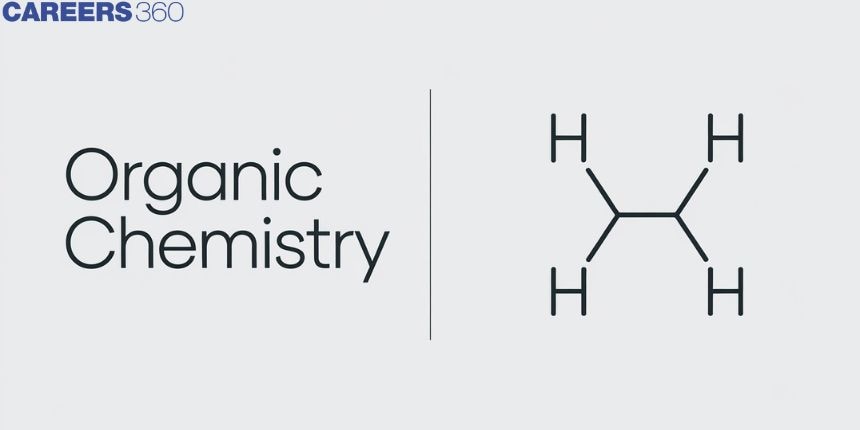Organic Chemistry - Reagents, Field Effects, Stability, Bond Cleavage
The compounds with carbon as one of the main elements are known as organic compounds. In organic compounds, the bonding between the atoms is covalent. When two atoms share their electron pair mutually, the bond formed between them is known as a covalent bond since carbon has four valence electrons. Carbon can neither lose nor accept a pair of electrons to form a bond with another element. That’s why carbons share the pair of electrons mutually with another element. The carbons also show the property of replication which is known as catenation.
This Story also Contains
- Skelton of Organic Reaction
- Types of Cleavage Of Bond
- Solved Examples Based On Organic Chemistry (Cleavage of Bonds)-
- Conclusion

In our day-to-day lives, various organic compounds are connected to us. These can be protein, carbohydrates, vitamins, and more. These compounds have one feature in common: they are made up of carbon and hydrogen. Therefore the carbon-hydrogen compounds are known as organic compounds.
In an organic reaction, the organic molecule (also referred to as a substrate) reacts with an appropriate attacking reagent and leads to the formation of one or more intermediate(s) and finally product(s)
The major reactant, which is attacked by some other chemical species, is called the substrate. eg. Alkenes, Alkynes, Benzene
A nucleophile (Nu:) is a reagent that adds an electron pair to the reactive site during a reaction. This type of reaction is known as nucleophilic. On the other hand, an electrophile (E+) is a reagent that removes an electron pair from the reactive site, and the reaction is called electrophilic.
Skelton of Organic Reaction
Ions are generally not formed in the reactions of organic compounds. Molecules as such participate in the reaction. It is convenient to name one reagent as substrate and other as reagent. In general, a molecule whose carbon is involved in new bond formation is called substrate and the other one is called reagent. When carbon-carbon bond is formed, the choice of naming the reactants as substrate and reagent is arbitrary and depends on molecule under observation. Some examples include:

Types of Cleavage Of Bond
A covalent bond can get cleaved either by:
- Heterolytic cleavage
- Homolytic cleavage
Heterolytic cleavage
In heterolytic cleavage, the bond breaks in such a fashion that the shared pair of electrons remains with one of the fragments. After heterolysis, one atom has a sextet electronic structure and a positive charge and the other, a valence octet with at least one lone pair and a negative charge. Thus, heterolytic cleavage of bromomethane will give CH3+ and Br– as shown below.![]()
Homolytic cleavage
In homolytic cleavage, one of the electrons of the shared pair in a covalent bond goes with each of the bonded atoms. Thus, in homolytic cleavage, the movement of a single electron takes place instead of an electron pair. The single electron movement is shown by ‘half-headed’ curved arrow. Such cleavage results in the formation of neutral species (atom or group) which contains an unpaired electron. These species are called free radicals. A homolytic cleavage can be shown as below:

Recommended topic video on (Organic Chemistry )
Solved Examples Based On Organic Chemistry (Cleavage of Bonds)-
Q.1 Identify the substrate in the following -
(1) $\mathrm{NO}_2^{+}$
(2) $\mathrm{CH}_2=\mathrm{CH}_2$
(3) $\mathrm{FeCl}_3$
(4)$\mathrm{H}_2 \mathrm{O}$
Solution:
As we learned -
In an organic reaction, the organic molecule (also referred to as a substrate) reacts with an appropriate attacking reagent and leads to the formation of one or more intermediate(s) and finally product(s)
The major reactant, which is attacked by some other chemical species, is called the substrate. eg. Alkenes, Alkynes, Benzene
A nucleophile (Nu:) is a reagent that adds an electron pair to the reactive site during a reaction. This type of reaction is known as nucleophilic. On the other hand, an electrophile (E+) is a reagent that removes an electron pair from the reactive site, and the reaction is called electrophilic.
The major reactant, which is attacked by some other chemical species, is called the substrate. eg. Alkenes, Alkynes, Benzene
$\mathrm{C}_2 \mathrm{H}_4$ (ethene ) is the substrate while $\mathrm{NO}_2^{+}$ and $\mathrm{FeCl}_3$ are electrophiles and $\mathrm{H}_2 \mathrm{O}$ is a nucleophile.
Hence, the answer is the option (2).
Q.2 In the reaction
$\mathrm{RCHO} \xrightarrow{\mathrm{LiAlH}_4} \mathrm{RCH}_2 \mathrm{OH}$
$\mathrm{LiAlH}_4$ is -
(1) Reagent
(2) Hydride based nucleophile
(3) both (a) and (b)
(4) Electrophile
Solution:
As we learned -
Lithium Aluminum Hydride$\left(\mathrm{LAH}, \mathrm{LiAlH}_4\right)$ for Reduction:
• Lithium aluminum hydride$\left(\mathrm{LiAlH}_4\right)$ is a potent reducing agent, which is even stronger than sodium borohydride $\left(\mathrm{NaBH}_4\right)$
It is a nucleophilic reducing agent that is best suited for reducing multiple polar bonds such asis $\mathrm{C}=\mathrm{O}$.
• $\mathrm{LiAlH}_4$ similar to $\mathrm{NaBH}_4$ reduces aldehydes and ketones to alcohols.
• However, unlike$\mathrm{NaBH}_4, \mathrm{LiAlH}_4$ can reduce carboxylic acids, esters, lactones, acid halides, and anhydrides to primary alcohols.
$-\mathrm{LiAlH}_4$ can also reduce nitriles and amides to amines.
• Finally$\mathrm{LiAlH}_4$can also open epoxides and reduce alkyl halides to alkanes.
The Species, that attacks the substance to get the major product, is called a reagent.
$\mathrm{LiAlH}_4$ is a hydride-based nucleophile. It works as a reagent in the chemical reaction.
$[\mathrm{H}$ from $\mathrm{LiAlH}_4$ attacks on the electron-deficient portion of the substrate.
Hence, the answer is the option (3).
Conclusion
Organic compounds are those compounds in which carbon and hydrogen atoms bonded together with covalent bonds. The organic compounds are non-polar. The functional group attached to the organic compounds completely changes its physical and chemical properties. The organic compounds can be classified as open-chain organic compounds and closed-chain organic compounds, which can be subdivided into different categories based on the saturation present in the compounds, respectively. The saturation is decided by the number of bonds present between the two carbon atoms present in the chain. The reactions of organic compounds typically do not produce ions.